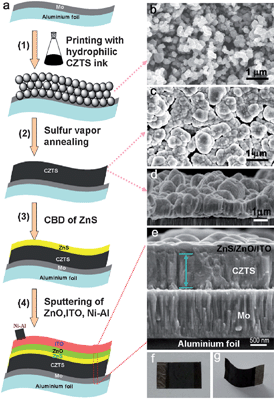The race is on to develop the most efficient, low-cost solar cells to meet the green energy demand of the future. Unfortunately, high power conversion efficiencies often come at high economic cost and so there is still a lot of room for improvement for existing materials and technologies.
Scientists from Donghua University, China, have now touched upon another desirable feature of solar cell materials – environmentally friendly synthesis. Junqing Hu and his team have sought to develop solar cells based on Cu2ZnSnS4 (CZTS) nanocrystal films.
 Previous reports using these nanocrystal inks or the selenised CZTSSe analogues have shown promise but their hydrophobic nature (due to the oleylamine capping agent) means they can only be dispersed in organic solvents. Other drawbacks to their synthesis include using cadmium in the buffer layer (environmental implications); glass substrates (inflexibility); and hydrazine as a precursor to the inks (toxic and difficult to handle).
Previous reports using these nanocrystal inks or the selenised CZTSSe analogues have shown promise but their hydrophobic nature (due to the oleylamine capping agent) means they can only be dispersed in organic solvents. Other drawbacks to their synthesis include using cadmium in the buffer layer (environmental implications); glass substrates (inflexibility); and hydrazine as a precursor to the inks (toxic and difficult to handle).
In their recent CrystEngComm Communication, Hu and colleagues describe the solvothermal synthesis of hydrophilic CZTS nanocrystal inks. By developing a film-printing technique they were able to fabricate a flexible and environmentally-friendly solar cell. Although the conversion efficiency is somewhat low (1.94 %) compared to other reported values for CZTSSe materials, the authors expect that it can be improved by optimising the film-printing technique, film thickness and annealing process, and selenising the film.
This HOT article is free to access until 19th March so download it now…
Hydrophilic Cu2ZnSnS4 nanocrystals for printing flexible, low-cost and environmentally friendly solar cells
Qiwei Tian, Xiaofeng Xu, Linbo Han, Minghua Tang, Rujia Zou, Zhigang Chen, Muhuo Yu, Jianmao Yang and Junqing Hu










